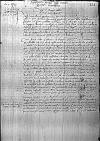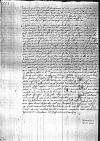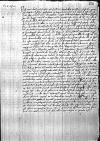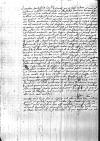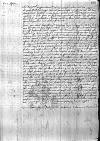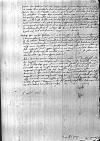Scripsi ⌊⌋ Maiestati Vestrae Serenissimae decima Ianuarii praeteriti, quarum his duplicatas si forsan non sint redditae, adiunxi, ex quibus per ordinem omnia, quae in negotio Barensi ac aliis in rebus acta sunt, abunde intellexit. Addidi praeterea exemplum ⌊⌋, quas ad magnificum dominum ⌊Ludovicum Aliphium⌋ ⌊hinc⌋ 1526-01-24⌊24 praeteriti mensis1526-01-24⌋ scripsi, unde etiam de his, quae cum ⌊caesare⌋ et ⌊magno cancellario⌋ in re Barensi egi, certior fiet. Quae interea se obtulerunt, per modum ephemeridum sic habent.
Cum pax inter ⌊caesarem⌋ et ⌊regem christianissimum⌋ 14 Ianuarii in ⌊Madrillis⌋ ab omni parte esset conclusa, ut ex articulis eiusdem videbitur, suborta fuit iterum inter ⌊magnum cancellarium⌋ et ⌊viceregem⌋ quaedam gravis dissensio ratione veritatis, quam bonus iste senex quantum potest libenter tuetur caesaremque ad eam amplectendam ducit ac impellit. Sed dum vidit se nihil proficere et adversariis suis plus fidei quam sibi adhiberi, rursus in priorem suam sententiam, de qua prius 10 Septembris ⌊⌋, incidit et bonis modis a ⌊caesare⌋, ut a curia cum gratia dimitteretur, rogavit, se iam postremo senio confectum domique res suas et amicorum suorum indispositas habere laboresque aulicos pertaesus et his fessus amplius se ferre non posse plusque in ⌊Italia⌋ se rebus suae maiestatis quam in curia commodum ac utilem futurum. Haec fuerunt verba, ut ipse mihi ⌊cancellarius⌋ retulit, quibus abitionem suam postulavit. Sed ⌊caesar⌋ haec in deliberationem accepit effecitque, quod usque ad ⌊Hispalim⌋ adhuc proficisci debeat, illic ea de re consilium cum eo habiturus. Unde cum sic ⌊cancellarium⌋ turbatum cognovi, nolui illi esse importunior, ipse nihilominus mihi consuluit, ut apud ⌊caesarem⌋ instarem et sollicitarem sedulo. Quod a me non fuit omissum, sed nihil aliud obtinere potui, quam hoc corvi carmen: cras, cras!
Interea exitus versus ⌊Madrill⌋ hinc a ⌊caesare⌋ parabatur, ut illic cum ⌊rege christianissimo⌋ conveniret illumque et omnia alia, quae in confecta pace agenda restabant, absolveret et inde recta versus ⌊Hispalim⌋ contenderet. Quod ubi compertum habui, velis et remis incubui, non veritus etiam, ut in agendo taedulus ⌊caesari⌋ fierem omnibusque modis et blandis et durioribus verbis promissum toties responsum postulavi. Hoc cum incassum aliquoties cessisset, tandem adegi eum, quod mihi pollicebatur: se in ⌊consilio statuum⌋ (Consultam hoc vocant) quod post prandium haberi debuit, negotii Barensis mentionem facturum operamque se, ut absolveretur, daturum. Rogavi summopere, ut sic fieret et subinde me ad ⌊cancellarium⌋ rursus contuli illique ⌊caesaris⌋ hoc responsum exposui orabamque, ut cum res haec tractaretur, benevolentiam suam, quam ad negotia Maiestatis Vestrae Serenissimae habet semper, illic etiam impartiret. Quod se facturum promisit, ut illius verbis utar, quantum esset possibile.
⌊Consulta⌋ haec habita fuit usque ad quartam horam noctis. Mane cum primum opportunum videbatur, iterum conveni ⌊cancellarium⌋, sed ille tum litteris legendis ex ⌊Italia⌋ occupatus rogavit, ut cum eo essem in prandio, quo facto mecum liberius posset conferre. Unde cum in conclave cum eo divertissem, consedimus, ⌊ille⌋, ut solet, subrisit. “Heri”, inquit, “longam ⌊Consultam⌋ habuimus, ex qua multis rebus infectis et vestra etiam discessimus; habemus unum diabolum — ⌊viceregem⌋ significando — qui non solum vestras, verum etiam ipsius ⌊caesaris⌋ omniumque statuum ⌊Italiae⌋ res turbat, et quamdiu ille praesens est, nulla in re quicquam boni fieri potest. Quapropter ego suadeo, ne in hoc exitu ⌊caesarem⌋ in negotiis vestris amplius molestetis, sed usque ad ⌊Hispalim⌋ deferatis, ubi omnia commodius expediri possunt. ⌊Iste⌋ enim
cf. Vulg. Is 14. 12-14 Quomodo cecidisti de caelo, Lucifer, qui mane oriebaris? corruisti in terram, qui vulnerabas gentes? Qui dicebas in corde tuo: In caelum conscendam, super astra Dei exaltabo solium meum; sedebo in monte testamenti, in lateribus aquilonis; ascendam super altitudinem nubium, similis ero Altissimo? ⌊daemon ⌊Luciper⌋, qui se vult aequare Altissimocf. Vulg. Is 14. 12-14 Quomodo cecidisti de caelo, Lucifer, qui mane oriebaris? corruisti in terram, qui vulnerabas gentes? Qui dicebas in corde tuo: In caelum conscendam, super astra Dei exaltabo solium meum; sedebo in monte testamenti, in lateribus aquilonis; ascendam super altitudinem nubium, similis ero Altissimo? ⌋, cum ⌊rege Galliae⌋ discedit, forte absente illo omnia melius dirigentur, ⌊ego⌋que id faciam, quod mihi est possibile.” Dixit etiam inter alia, quod omnes consiliarii adhuc in prima sententia persisterent: ⌊caesarem⌋ non debere hoc mutare, quod semel decrevit, sed permittere Maiestati Vestrae Serenissimae, quod ⌊castro Barensi⌋ castellanum praeficiat, quemadmodum in litteris remotionis sequestri fuit expressum. Multaque alia mihi retulit, quae in exemplo ⌊⌋ mearum ad dominum ⌊Ludovicum Aliphium⌋ videbuntur. Inde Maiestas Vestra Serenissima cognoscet, quo ⌊vicerex⌋ ⌊caesarem⌋ ducebat et quid ille, si potuisset honesto modo, in mente habuit, quae certe nemo, quam ⌊cancellarius⌋ hactenus impedivit.
Dixit mihi etiam eodem tempore ⌊cancellarius⌋, qua de re licentiam, ut vocant, a ⌊caesare⌋ domum eundi a curia petivisset, quod omnia videret sine ordine et perverse dirigi ac saniora consilia sperni, perperamque multa tractari, quod rebus caesaris nequaquam bene cedere posset servitiorumque et fidei suae rationem nullam haberi, implicatumque se esse multis debitis, ex quibus sub his expensis, quas in curia facere cogitur, difficulter se explicare posset. Nihilominus se adhuc esse a ⌊caesare⌋ inductum, ut ad ⌊Hispalim⌋ proficisceretur, quod negare non potuisset. Si tamen illic etiam hunc transversum agendi ordinem non immutari cognosceret, ulterius nequaquam ⌊se⌋ in curia mansurum. Cum ego interrogarem: quando ⌊caesar⌋ hinc certo abire deberet, nam per decem fere dies illius exitus in crastinum semper ducebatur, ille mihi ⌊Salomonis⌋ hoc
respondit: cf. Vulg. Prv 30. 18-19 Tria sunt difficilia mihi, et quartum penitus ignoro: viam aquilae in caelo, viam colubri super petram, viam navis in medio mari, et viam viri in adolescentia ⌊tria esse investigabilia et quartum, quod penitus ignoraret: viam volantis aquilae in aere, viam navis in mari, viam serpentis super petram et viam iuvenis in adolescentia suacf. Vulg. Prv 30. 18-19 Tria sunt difficilia mihi, et quartum penitus ignoro: viam aquilae in caelo, viam colubri super petram, viam navis in medio mari, et viam viri in adolescentia ⌋, quod ultimum cum accentu et affectu quodam pronuntiavit, subestque aliquid. Cum, quid de pace hac conclusa sentiret, quaererem: „⌊Ego⌋,” inquit, „postquam omnes desperabant, ego solus bene speravi, nunc cum omnes bene sperant, ego despero. Videbit, inquam, ⌊caesar⌋ in istarum rerum fine, quis illi fidelius consuluit. Utinam sim vanus vates.” Haec et multa alia, quae longum esset recensere, inter nos habita sunt et conclusum, ⌊caesarem⌋ in exitu me alloqui magis non debere illumque usque ad ⌊Hispalim⌋ sequi.
Ex his Maiestas Vestra Serenissima, quomodo huc usque omnia habeant, liquido cognoscet. Accingo me igitur ad hoc iter et cogor me denuo cum equis iterum instruere novosque sumptus facere. Cum ⌊hic⌋ omnia in exitu, quae viam spectant, pretiosiora sunt, quam antea fuerunt, vix 50 ducatis me expediam, quo fit, ut prius in novissimis scripsi, quod usque ad medium Aprilis cum pecuniis mihi a domino ⌊Ludovico Aliphio⌋ missis, trecentis videlicet ducatis, me sustinere non potero. Qua propter ad hanc viam in omnem eventum a ⌊Welzeris⌋, datis litteris cambii ad dominum ⌊Nicolaum Antonium Carminianum⌋, quem dominus ⌊Ludovicus⌋ thesaurarium ⌊status Barensis⌋ reliquit, alios iterum trecentos ducatos accepi. Multae ⌊hic⌋ profecto pecuniae expenduntur, quibus in stuporem aliquando vertor et timeo, ne mihi suspicionem aliquam fidei meae non convenientem et inde indignationem pro gratia, quam a Maiestate Vestra Serenissima spero, pariant, fretus tamen fide et innocentia mea, prudentia item incomparabili Maiestatis Vestrae Serenissimae, quae cum calculum meum aliquando videbit, non aliud de me, quam quod fideli subdito et servo convenit, experietur. Cum istis 300 ducatis usque ad Iunium futurum me sustinebo, aliter enim hic et necessitate et honore Maiestatis Vestrae Serenissimae exigente pro oratore sustinere me non possum.
Iam fere sextus mensis agitur quod neque post ⌊⌋, quas 10 Septembris cum ⌊Pantaleone⌋, neque post alias meas in ⌊⌋ et ⌊⌋ ad Maiestatem Vestram Serenissimam datas, responsum aliquod accepi, habeo igitur certam fiduciam, quod brevi Maiestatis Vestrae Serenissimae litteras sum habiturus, quae mihi laetum reditus mei nuntium sint allaturae priusquam isti hic aestus excandescent, quos non parum metuo, non oblitus, quid superiori aestate sum perpessus, quandoquidem causam non video, propter quam Maiestas Vestra Serenissima amplius hic mecum tantas expensas facere debeat. Negotium de ⌊castro Barensi⌋ iam prope finem est, quod credo in ⌊Hispali⌋ perficietur. Quod si ⌊caesar⌋ ⌊castrum hoc⌋ ex instituto in regno observato, vel ob quoscumque alios respectus retinere seu occupare voluerit, quod tamen mihi non persuadeo, necessario sequi opportet, quod etiam impendat, quo conservetur. Hoc ex usu et re ⌊illi⌋ esse
nequit, quocirca spem de recuperatione non levem concipio. Quae cum facta et ea, quae hunc statum spectant, certo ordine firmata fuerint, supervacanea hic mora mea ulterior esset. Quae Maiestas Vestra Serenissima et alia, quae adhuc expedire videbuntur, pro summa sua sapientia bene perpendet. Ego me ex mandatis Maiestatis Vestrae Serenissimae cf. Pl. Aul. 56-57 si hercle tu ex istoc loco digitum transvorsum aut unguem latum excesseris; Adagia 406 ⌊ne latum quidem unguem movebocf. Pl. Aul. 56-57 si hercle tu ex istoc loco digitum transvorsum aut unguem latum excesseris; Adagia 406 ⌋, quicquid Maiestas Vestra Serenissima de me statuerit, modo illius cum gratia servire possim, perferam libenter.
⌊Caesar⌋ ⌊hinc⌋ 1526-02-12⌊12 istius1526-02-12⌋ versus ⌊Madrill⌋ solvit tota curia hic relicta et cum ⌊rege christianissimo⌋ inter quintam et sextam horam vesperi cum multis caeremoniis convenit. ⌊Rex⌋ ⌊illi⌋ usque extra portam oppidi ivit obviam. ⌊Quem⌋ cum ⌊caesar⌋ supra mulam tardius progredientem vidisset, ipse equo vectus alacri cursu ad eum contendit et, ut ferunt, humanissime excepit adegitque illum ut hospitem in ⌊Hispania⌋ et futurum sororium, quod dextrum inter eundum latus acciperet diuque reluctantem hoc modo in castrum illic comitatus est; multis officiis amoris et benevolentiae plenis erga eum usus, non sine spectatorum summa admiratione. Fuerunt ibidem una per tres dies, genio, ut haec tempora exposcebant, et familiaribus colloquiis indulgentes. ⌊Caesar⌋ neminem oratorum, ut ⌊regem⌋ compellarent hinc secum proficisci permisit, licet hoc omnes postulassemus. Cur hoc factum sit, varii multifariam interpretantur. Ego certe ⌊regem⌋ libenter convenissem, cum, ut illi de hac confecta pace nomine Maiestatis Vestrae Serenissimae fuissem congratulatus, tum etiam, ut illi mandata novissima de ⌊castro et statu Barensi⌋ Maiestatis Vestrae Serenissimae exponere potuissem, utpote si ei expedire visum fuisset, pro mutua cum Maiestate Vestra Serenissima coniunctione ⌊caesarem⌋ alloqueretur ac intercederet, quo castrum Barense, quod a statu illo iure avelli nequit, rursus in potestatem Maiestatis Vestrae Serenissimae perveniret. Sed cum illac nemo de oratoribus fuerat admissus, et ego me continui, nihilominus unum de meis, nobilem ⌊Fabianum Woyanowski⌋, famulum ⌊reverendissimi domini Cracoviensis⌋, iuvenem satis industrium, ad illum conventum misi dedique ei litteras ad dominum ⌊Stanislaum Laski⌋, fratrem magnifici ⌊palatini Siradiensis⌋, quem apud ⌊regem⌋, cum oratorem istic ageret, reliquerat, ut per medium illius id, quod mihi Maiestas Vestra Serenissima iniunxerat, in notitiam regis perveniret. Sed sors aliter vertit, nam domina ⌊dux de Alenzon⌋, soror ⌊regis⌋, cum ex ⌊Hispania⌋ discederet, illum secum cum quibusdam aliis nobilibus in ⌊Galliam⌋ abduxerat, unde ob acrem et occultam custodiam, quae de rege et eius comitibus habebatur, ea in re ⌊nuntius meus⌋ nihil efficere potuit. Et sic, uno equo iterum destructo, quem ex ⌊Neapoli⌋ hucusque fovi, rediit et omnes caeremonias illic habitas mihi retulit, quas cum sint rarae et vix multis saeculis eveniunt, praesertim inter duos tantos ⌊principes⌋, annotare non supervacaneum censui.
Post tres dies, ut scripsi, cum simul in ⌊Madrillis⌋ fuissent, dispositum erat, ad ⌊regis⌋, ut fertur, postulata, quod ⌊regina Leonora⌋ ad ⌊Ilescus⌋, oppidum abhinc sex miliaria nostra, diverteret, magno videndi regem desiderio flagrans, quod de rege, ut eam videret, etiam creditum est. Qua de re 16 istius ex ⌊Madrillis⌋ solverunt et 4 miliaria progressi, in ⌊Torison⌋ oppidum diverterunt, illic in una pariter domo hospitio suscepti, dulci familiaritate et consuetudine iuncti, pernoctarunt. Sequenti die ⌊Ilescus⌋, cum prioribus caeremoniis, ⌊rege⌋ ad dextrum latus obequitante, intrarunt et paulo post domum simul, ubi ⌊regina⌋ deversabatur accesserunt, quae cum puellis suis et mundo muliebri descensis gradibus usque ad portam domus illis ivit obviam exceptique utrimque per oscula, ut in ⌊Gallia⌋ usu receptum est, in aulam ad id peripetasmatis exornatam devenerunt. Consessum est illic. Erant ibi de primoribus heroinis istarum regionum plurimae, inter quas fuit ⌊regina Germana⌋ relicta vidua olim nepotis Maiestatis Vestrae Serenissimae marchionis ⌊Ioannis Brandeburgensis⌋ et ⌊comitis de Nassau⌋ coniunx ⌊marchesa de Zenete⌋. Dici nequit, quam alacrem et hilarem se ⌊rex⌋ vultu omnibus ostenderit perinde atque in ⌊Gallia⌋ in consuetis suis symposiis, visus est saepius ipse ibi blandiri iocari omnes et praecipue ⌊reginam⌋ ambire alloqui choreas ducere omnibus denique placere satagebat adeo, ut cunctis, qui prius eum norint, admirationi fuerit. Transactis sic tribus et ultra horis, postquam valedictum fuit, ⌊caesar⌋ cum ⌊rege⌋ per duo miliaria nostra rursus ad ⌊Torison⌋ retrocesserunt et ea nocte multa feruntur mutuo contulisse; et licet, ut scripsi, ⌊reginae⌋ vale iam dictum fuerat, nihilominus mane facto iterum ad eam concesserunt, et ut prius plures horas mutuis colloquiis ac tripudiis absumpserunt. Inde item valedictione facta ad ⌊Torison⌋ sunt reversi et postero die, qui fuit 19 huius, cum laute simul epulati fuissent et quam familiarissime satis longo tempore inter se de plurimis contulissent, classicum ad abitionem insonuit. Unde iterum conscensis equis ⌊caesar⌋ ⌊regi⌋ ultimum vale dicere statuit, quod eo in loco rex recusavit per longius illum prosecutus spatium et tandem, quasi ab eo invitus avelleretur, per mutuos amplexus fuit discessum. ⌊Caesar⌋ recta versus ⌊Hispalim⌋ et ⌊rex⌋ cum ⌊vicerege⌋ ad ⌊Burgos⌋, obsides illic exspectantes, iturus. Iste est istius congressus finis; utinam ex eo ⌊Orbi Christiano⌋ haec, quae sperantur commoda eveniant, sed
cf. Ov. Ep. 17 263-264 sed nimium properas, et adhuc tua messis in herba est / et mora sit voto forsan amica tuo; Adagia 1189 in herba esse ⌊adhuc haec messis in herba estcf. Ov. Ep. 17 263-264 sed nimium properas, et adhuc tua messis in herba est / et mora sit voto forsan amica tuo; Adagia 1189 in herba esse ⌋.
⌊Regina Leonora⌋ huc rursus concessit praestolarique hic debebit, donec omnia, quae in pace tractata sunt, perficiantur. Timeo, ne bona ista ⌊princeps⌋ diutius, quam velit, exspectet. Multum est mutata ab illa, qualem ego eam ante annos decem apud divum olim ⌊Maximilianum caesarem⌋ in ⌊Brabantia⌋ ⌊Brussellis⌋ videram, plurimum formae et decori per tam breve spatium est derogatum, pinguis non parum facta, vultu crassiore, pustulis rubris ad elephantiasim fere declinantibus infecto. Certe minimum aut nihil picturae, quam Maiestas Vestra Serenissima habet, ad praesens respondet. Agit hic non omnimode de ⌊fratre⌋ contenta, qui discedens, cum ipse egeret, ⌊illi⌋ etiam non abunde providit. Quapropter hic ⌊illius⌋ officiales sycophantias seu, ut hic vocant, finantias pro conquisitione pecuniarum struunt, idque quod anno futuro de dote sua ex ⌊Portugalia⌋ habere deberet, foeneratoribus, non parva summa relicta, accipere cogitur et pro hoc tempore impendere. Cum hoc fit ⌊sorori⌋, facilis est coniectura, quid cum aulicis fiat, quorum hic adhuc magna pars est, qui a creditoribus nondum sunt absoluti.
⌊Dux Borbonensis⌋ etiam hinc 16 istius versus ⌊Caesaraugustam⌋ cessit, cuius comites, ne de ipso dicam, aestive in ⌊Italiam⌋ viaticati, quod umquam huc venerint imprecantes discesserunt. Intelligo tamen ⌊eum⌋ ante consumptum ⌊caesaris⌋ matrimonium mari se non crediturum, hinc ulteriorem, ut alii omnes provisionem, exspectabit. Quocirca ⌊caesar⌋ in hoc itinere parum cunctabitur, ut ante ⌊Hispalim⌋ ⌊sponsam⌋ suam cum tam ampla, ut prius scripsi, dote conveniat. Postquam hymenaeum cum ⌊illa⌋ magna pompa, quemadmodum hic passim fertur, ⌊Hispalim⌋ ingredietur. Ubi non diu est immoraturus, inde ⌊Cordubam⌋ ⌊Granatam⌋ ⌊Valentiam⌋ et tandem ⌊Barzalonam⌋ concessurus, et habita classe ⌊regis Galliae⌋, ut in articulis pacis est conclusum, versus ⌊Neapolim⌋, quod pro festo Ioannis 25 Iunii, fertur, futurum, et inde pro coronatione ⌊Romam⌋ iturus. Longa haec erit peregrinatio et in aestibus non parum taediosa. Quod si me interim Maiestas Vestra Serenissima revocare dignabitur, nihil mihi fieri potest commodius et gratius, si etiam aliter visum fuerit, omnia mihi pro Maiestate Vestra Serenissima non gravate sunt perferenda. Fiat voluntas Domini.
⌊Magnus cancellarius⌋ 17 istius hinc solvit. Iterum podagra, quam hic guttam vocant, correptus, cum ultra solitum morem cum ⌊duce Borbonensi⌋, cui bene vult summopere, cenasset. In lectica itaque versus ⌊Hispalim⌋ defertur, ipse ⌊dux⌋ ⌊caesarem⌋ in ⌊Italiam⌋ praecedet, ⌊statum Mediolani⌋, ut constans fama est, habiturus; utque ⌊Franciscus⌋ bonis modis ex castro protrahatur, fertur, quod ⌊caesar⌋ ex eo per medium ⌊pontificis Romanorum⌋ cardinalem facere intendat, quae vita illi melius competet, cum alias ignaviae ventri et luxui deditus perhibeatur mavultque confessor quam martyr mori etc.
⌊Rex Franciae⌋, postquam obsides, ut in articulis pacis continetur, in ⌊Hispaniam⌋ venerint decima die futuri Martii postliminio in ⌊Galliam⌋ revertetur, ut ea, quae pro pacis conservatione hic tractata sunt, exsequatur. Et ne quicquam de his tractatibus Maiestatem Vestram Serenissimam lateat, impendi omnem operam, qua articulos confectos et Gallice summatim descriptos obtinui; quos utcumque Latine versos his annexis Maiestati Vestrae Serenissimae cum meis scholiis mitto. Ex quibus omnia hic conclusa cognoscet. Qui ⌊regem Galliae⌋ melius quam ego norunt, dicunt illum licet libere plerumque loquatur,
cf. Cic. Marc. 22 Sed tamen cum in animis hominum tantae latebrae sint et tanti recessus, augeamus sane suspicionem tuam ⌊profundissimi esse cordis et in eo multas habere latebrascf. Cic. Marc. 22 Sed tamen cum in animis hominum tantae latebrae sint et tanti recessus, augeamus sane suspicionem tuam ⌋
mirisque modis omnia dissimulare posse perinde atque non dissimularet, unde licet, ut fertur, ⌊caesar⌋ totus in eum confidat neque sibi permittat quicquam illi contrarium dici, nihilominus hic suspicio non levis et ingens dubium, donec 47 isti articuli perficiantur, apud plurimos manebit, non obstante etiam, quod caesar illi vellus aureum reddiderit, quod in principio belli ei rex remiserat; Deus tamen,
cf. Vulg. Prv 21. 1 sicut divisiones aquarum ita cor regis in manu Domini ⌊qui corda regum in manu sua habetcf. Vulg. Prv 21. 1 sicut divisiones aquarum ita cor regis in manu Domini ⌋, omnia in meliorem finem, quam creditur, derigere potest.
Ex hac pace si durabit neminem reor maius commodum et emolumentum, quam ⌊Luciperum⌋ illum, ut ⌊cancellarii⌋ verbis utar, ⌊viceregem⌋ habiturum, quem ut caesar contentum redderet, cum fortassis illi de ⌊statu Barensi⌋ satisfacere non potuit, dedit ei in ⌊regno [Nea]politano⌋, de quibuscumque proventibus ipse voluerit, supra id, quod prius ratione officii habet, sedecim mille ducatos annuos, fuitque mihi dictum, quod huiusmodi summam ei tamdiu dedisset, donec de statu Barensi Maiestati Vestrae Serenissimae per aliam recompensam satisfieret. Hoc cum ⌊cancellario⌋ retulissem: “hanc”, inquit, “condicionem a ⌊caesare⌋ non audivi, sed bene verum est, quod sedecim milium ducatorum meminit, se ⌊illi⌋ tantum annuatim dedisse, sine tamen ista interiectione.” Dixit item mihi eo tempore ⌊cancellarius⌋, quod ⌊caesar⌋ ab ⌊eo⌋ quaesivisset, si non possent inveniri modi, quibus Maiestas Vestra Serenissima contenta redderetur de ⌊statu Barensi⌋, ad quod se respondisse ut prius, quemadmodum in exemplo ⌊⌋ mearum ad dominum ⌊Ludovicum⌋ habetur. Datus est etiam a ⌊caesare⌋ ⌊viceregi⌋ ⌊comitatus de Asti⌋ in ⌊Subaudia⌋, ex quo prope decem et octo mille ducatos annuos percipere poterit. In ⌊Germania⌋ insuper inferiore etiam ⌊illi⌋ non parum datum est, sic quod in summa ex hoc bello et pace a ⌊caesare⌋ plus quam quadraginta milia ducatorum de annuis proventibus acceperit. Quid adhuc a ⌊rege Galliae⌋ est habiturus, dicebatur hic, ut scripsi in novissimis: quod rex ⌊illi⌋ ducentena milia scutorum promiserit, cum quo nunc in ⌊Galliam⌋ proficiscitur et sine magno munere, cum istius liberationis auspex fuerit, ab eo non dimittetur.
cf. Dantisci Carmina l. 493-494 Sic variat Fortuna vices: quem tollit in altum, Deprimit, et quem nunc presserat, inde levat. ⌊Sic mutat fortuna vices, quem tollit in altum, deprimit, et quem nunc presserat, inde levat.cf. Dantisci Carmina l. 493-494 Sic variat Fortuna vices: quem tollit in altum, Deprimit, et quem nunc presserat, inde levat. ⌋
Sed, ut philosophi dicunt: nullum violentum perpetuum, quod cito fit, cito perit.
Legatus ⌊pontificis⌋ ⌊cardinalis Salviatis⌋, qui, ut ⌊regem⌋ videret, non parum apud ⌊caesarem⌋ institit, unde ad illum in ⌊Madrillis⌋ per breve temporis spatium, sed non sine arbitris, fuit admissus. Venatur hic cruce facultatibus ac indulgentiis suis non pauca, quae tamen statum eius, ut reor, sustinere non possunt, et cum interdum caecultat, ut eius generis est, etiam in ⌊Hispaniam⌋ lectica producitur. Fortassis nuptiis seu copulae ⌊caesaris⌋ intererit, nos alii oratores recta ad ⌊Hispalim⌋ praemittimur. Credo, quod istae nuptiae parva impensa celebrabuntur quodque ad eas pauci etiam vocabuntur. Hic adhuc ea et maiore penuria quam ante laboratur, quo fit, quod in istis futuris ardoribus per haec ⌊regna Gaditana⌋, ut scripsi, pecuniae omnibus modis quaerentur; nam in eis ⌊caesar⌋ numquam fuit prius et, si pro futura aestate in ⌊Italiam⌋ traicere volet, sine nervo illi nequaquam poterit esse integrum. Audivi ⌊magnum cancellarium⌋ dicentem, astantibus quam plurimis, quod si ⌊caesar⌋ hoc anno ⌊Italiam⌋ non attigerit, postea frustra conari; hoc ego etiam, quantum meo iudicio possum assequi, rebus sic stantibus credo certo futurum. Qua de re donec ferrum candet exercebunt et in usus suos vertent, quod si refrixerit, validi incudibus ictus et bracchia multa vi in numerum extensa non proderunt. In hoc itaque ad praesens incumbunt. Missae sunt ad omnes, ut suspicor, reges et principes praesertim in ⌊Germaniam⌋ litterae, quibus ista profectio denuntiatur et ab eis solitae suppetiae postulantur, voluitque hinc ⌊caesar⌋ ⌊comitem de Nassau⌋ ad electores imperii et ad nescio quos alios mittere, sed ille se omnibus quibus potuit, rationibus ab hoc itinere redemit, nam alias in Germania non apud omnes bene audit sique hinc abiisset, caesar hic solus fuisset relictus. Dominus ⌊maiordomus maior⌋ gubernator ⌊Bressae⌋ hodie hinc ivit, ut ⌊Burgundiae⌋ possessionem capiat, dominus ⌊Beulrein de Rois⌋ ivit in ⌊Flandriam⌋, non omnimode contentus, is enim ⌊duci Borbonensi⌋ ⌊sororem⌋ ⌊caesaris⌋ promiserat. ⌊Vicerex⌋ in ⌊Galliam⌋ proficiscitur, ⌊cancellarius⌋ etiam, ut scripsi, ⌊Italiam⌋ petere statuerat. Quo factum est, quod dominus ⌊comes de Nassau⌋ hic remansit, non invitus certe; nunc apud illum erit rerum arbitrium.
Scriptae etiam hinc sunt a ⌊caesare⌋ ad Maiestatem Vestram Serenissimam litterae, quarum cum praesentibus exemplum mitto, significaturque Maiestati Vestrae Serenissimae pacem et foedera haec esse confecta eamque in illa cum reliquis regibus et principibus inclusam. Has ego litteras cum de ⌊statu Barensi⌋ nihil in se continebant, de quo rogaveram, ut Maiestati
Vestrae Serenissimae responderetur, ad me accipere nolui, nam hoc negotium, de quo scribitur, ego hic non procurabam; missae sunt igitur ad dominum ⌊archiducem Austriae⌋ in ea forma, quemadmodum aliis regibus ac principibus in hac pace et foedere comprehensis scriptum est. Gloriosae tamen sunt, ut videbitur, huicque nationi, cuius illarum fuit auctor, respondent, quandoquidem hic aliter sentimus.
Iam per alias digressiones ⌊viceregem⌋ hunc reliqueram, ne tamen de his, quae hic per me sciri possunt, Maiestatem Vestram Serenissimam, cum de omnibus vult habere scientiam, quicquam praetereat, iterum ⌊Luciperum⌋ illum conveniam, de quo intellexi effecisse eum, quod ⌊granmetter⌋ seu maiordomus maior ad ⌊Burgundiae⌋ possessionem capiendam sit missus. Nam ⌊illi⌋ cum ⌊cancellario⌋ bene convenit egisseque eum tantum apud ⌊caesarem⌋, quod officium hoc domus ei dederit et ipse aliud officium stabuli, quod interim, quo ⌊vicerex⌋ fuit, numquam dimisit, ⌊comiti de Hegmunth⌋ ex ⌊Hannonia⌋, quem ille in gratiam ⌊caesaris⌋ promovit, resignavit, idque sub hoc praetextu fecerit, cum hic passim dicatur ⌊regem Galliae⌋ fidem non observaturum, quod ipse igitur in curia caesaris vult esse concordiamque hanc et amicitiam inter caesarem et
cf. Vulg. Prv 21. 1 sicut divisiones aquarum ita cor regis in manu Domini ⌊regem, cuius ille cor in manibus haberecf. Vulg. Prv 21. 1 sicut divisiones aquarum ita cor regis in manu Domini ⌋
gloriatur, firmiorem in dies et perpetuam facere contra omnium opinionem, qui aliter sentiunt. Et hoc contra ⌊cancellarium⌋ — cf. Ter. An. 126 ⌊hinc illae lacrimaecf. Ter. An. 126 ⌋ — quodque hoc itinere, cum ⌊regem⌋ in ⌊Blais⌋ perduxerit, recta ⌊Neapolim⌋ contendet illicque ex mandato ⌊caesaris⌋ alium viceregem, quem sibi expedire cognoscet, instituet et inde ad officium hoc domus ad caesarem revertetur. Haec est illorum sententia, qui cum ⌊eo⌋ versantur. Aliud tamen ab aliis dicitur: ⌊ipsum⌋ videlicet in ⌊regno Neapolitano⌋ plurimos habere, quos sibi non abs re hostes fecerit; ab illis timere exitium, quod illum certo, si diutius ibi ageret, maneret. Proinde consulens saluti suae, hoc commentum sub specie fidei ⌊caesari⌋ proposuisse, cui bonus iste iuvenis, qui hodie 26 aetatis annum exegit, credens, omnia ⌊illum⌋ agere permittit. Ego tamen etiam non parum in causa fuisse arbitror: quod igitur amplius vicerex esse nolit, cum videt ⌊se⌋ ⌊statum Barensem⌋, in quo satis tutus fuisset, obtinere non posse, nam in eum totam suam fiduciam locaverat, mavultque esse hic, ubi viceregibus et omnibus imperare potest. Sed hoc unum ⌊Lucani⌋ me consolatur:
cf. Luc. 8 21-22 poenas longi Fortuna favoris exigit a misero ⌊⌊Magni⌋ brevis est fortuna favoriscf. Luc. 8 21-22 poenas longi Fortuna favoris exigit a misero ⌋, praesertim cum animus ⌊istius principis⌋ paulo momento huc vel illuc impellitur, quod per non unam iam metamorphosim hic sum expertus.
Venit huc nuper in postis a domino ⌊archiduce⌋ ⌊Salamanca⌋ ⌊thesaurarius⌋,
qui fertur futurae ⌊imperatrici⌋ torquem viginti milium ducatorum valoris attulisse. Quid ⌊iste⌋ egerit, nam non in itinere a ⌊caesare⌋ est expeditus, adhuc scire non possum, cum tempore tamen, sit etiam quantumvis latens, expiscabor aliquid. Fuit huc scriptum, quod Maiestas Vestra Serenissima cum nepote suo serenissimo ⌊Hungariae rege⌋ in ⌊Moravia⌋ pro Ianuario praeterito convenire debuerat et postea ea de re nihil est innovatum hic, et ne verbum quidem amplius.
Convenit me nuper apud ⌊magnum cancellarium⌋ dominus ⌊Vilhelmus de Rogendorff⌋, cum quo mihi adhuc in aula ⌊caesaris Maximiliani⌋ praeclarissimae memoriae antiqua fuit consuetudo. ⌊Hic⌋ in curia peditum ⌊Germanorum⌋ et aliorum, qui hactenus circa ⌊Perpinianum⌋ in finibus ⌊Cataloniae⌋ excubias servarunt, capitaneus est et non parvae apud ⌊caesarem⌋ ⌊comitem de Nassau⌋ et ⌊dominum cancellarium⌋ auctoritatis, vir certe inter istas nationes pro Germano sagax et industrius. ⌊Ille⌋ mecum ab ovo exorsus, quod semper rebus Maiestatis Vestrae Serenissimae libenter inservivisset, repetens id, quomodo me una cum eo ⌊caesar Maximilianus⌋ ad corrumpendam anum, quae 1517-00-00⌊tunc1517-00-00⌋ ⌊Leonoram⌋ dirigebat, ut eius animum Maiestati Vestrae Serenissimae afficeret, mississet et ego mille ducatos, quos caesar mihi dare voluit, anui promisissem, ut matrimonium hoc conficeret etc. quodque eo et ab eo tempore libenter Maiestati Vestrae Serenissimae servivisset et ad praesens etiam esset istius animi, ubi illi commodo et honori esse posset, longa istiusmodi pro sua facundia usus praefatione. Qua de re, cum intellexisset matrimonium, quod Maiestati Vestrae Serenissimae propositum fuisse sciret, inter ⌊marchionem Mantuanum⌋ et ⌊primogenitam⌋ Maiestatis Vestrae non successisse, aliud se honestius et commodius scire. Cumque ad haec verba pervenisset, vocatus fui a ⌊cancellario⌋. ⌊Ille⌋ se alio tempore ad me venturum pollicebatur, dicens: si in his quicquam conficeretur, quod etiam operae meae digna ratio haberi deberet. Cumque illa agerentur in exitu ⌊caesaris⌋, ad me non pervenit amplius, oblitus forsan, vel, quod credo potius, de industria omisit, vale tamen per alios, sine aliqua adiectione, mihi denuntiavit. Unde suspicor nihil aliud, quam de ⌊duce Borbonensi⌋ fuisse hoc negotium, apud quem semper esse solebat. Desperat forsan propter coniunctionem Maiestatis Vestrae Serenissimae cum ⌊rege christianissimo⌋ id non posse confici, quod etiam quemadmodum alia leviora in notitiam Maiestatis Vestrae Serenissimae perducendum existimavi.
Et ne quicquam intactum relinquam. Semper nova hic habentur vaticinia, quibus a plerisque creditur. Est hic quidam ⌊episcopus Nicensis⌋, de quo prius aliquoties scripsi, is se ex cuiusdam monialis praedictione summum
pontificem Romanorum futurum somniat, captivitatem revera ⌊regis Franciae⌋, quae ut hodie anno praeterito fuit et plura alia, quae evenerunt, praedixit. De eo item novum habet vaticinium, quod passim coram omnibus sub his verbis profert: Surget rex e carcere, fretus ingenio, multa promittet, pauca servabit, plurima exiget et cetera. Hoc et cetera quid sibi velit, nulli vult declarare. Videt etiam, cum ista coram ⌊cancellario⌋ diceret, litteras ⌊Venetorum⌋ ad ⌊caesarem⌋, quarum suprascriptio fuit serenissimo et excellentissimo principi etc. cum toto titulo et in fine sine aliqua adiectione fuit ultimum archiduci Austriae etc. Ad haec ille: Brevi scribent: Domino nostro clementissimo. Quid ex his erit futurum, experientia docebit.
Utque per modum epilogi rerum mihi commissarum adhuc reminiscar. Sum constans in ea qua prius opinione, quam aliquoties descripsi, quod de ⌊statu Barensi⌋ et praesertim quod castrum spectat omnimodam absolutionem et certitudinem Maiestas Vestra Serenissima non est habitura, quousque cum ⌊Gallis⌋ omnia perficiantur; inde fabricato consilio ⌊caesar⌋ responsum suum, propter quod a me toties est impulsus, dabit; et cuius sit sententiae ac mentis erga Maiestatem Vestram Serenissimam se planius declarabit. Quod brevi spero futurum.
Alia hoc tempore digna scientia Maiestatis Vestrae Serenissimae se non offerunt; ex ⌊Hispali⌋, Deo bene favente, quomodo nuptiae istae transactae sint et de omnibus aliis, quae interim evenient, scribam quam copiosissime. Commendo me et causam sororis meae, quam ⌊reverendissimus dominus meus Cracoviensis⌋ exponet, suppliciter Maiestati Vestrae Serenissimae, quam Deus Optimus Maximus per omnem felicitatem ac dierum longitudinem quam diutissime augeat, conservet atque tueatur, meque hic mori non permittat, priusquam illius manus, more Hispano, humillime coram exosculer.
